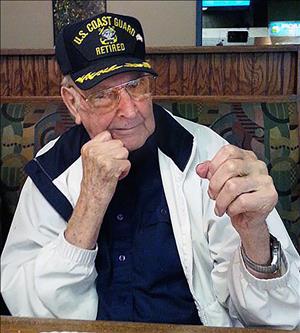Morest L. (Morey) Skaret (b. 1913), a longtime resident of West Seattle, worked for several summers in the early 1930s as a lifeguard at the original swimming pool at Lincoln Park, earning 30 cents an hour. The pool was built in 1925 at Point Williams, where there was a natural lagoon. It was part of a package of city-financed improvements prompted by a Knights Templar convention in the park that summer. A creosoted wood sluice gate allowed the dirt-sided pool to be filled with salt water at high tide and drained at low tide. The pool was replaced in 1941 by a heated concrete pool and brick bathhouse named after Fauntleroy-area philanthropist Laurence J. Colman. In this article, published in the Summer 2000 edition of the Fauntleroy Community Association’s quarterly newsletter, Neighbors, Skaret explains how the first pool was built and operated. This essay was edited by Cassandra Tate.
Swimming with the Fish
What fascinated me as a young man and still does is how simply the pool operated. It was dug and operated entirely by hand, with no machinery of any sort, and it was very clean, not the mud hole that some describe.
The city built it in 1925 after officers of the Knights Templar, a national men's group, expressed interest in having their convention in Seattle. They wanted to offer an "auto camp" for attending families at Lincoln Park and knew that the chance to swim in saltwater would be a big draw, especially for their members from inland states. The saltwater natatorium at Luna Park would not be convenient and Puget Sound's 52-degree water would not be to their liking! So the city decided to build a sun-warmed outdoor pool in the sand at Point Williams; families could camp up in the park and come down to the beach pool for their swim. The tide left a few inches of water in a low spot, making a bit of a lagoon, and that's where city engineers laid out the pool.
At 80 feet wide and 200 feet long, it was larger than the concrete Colman Pool that replaced it in 1941. It was shallow on the north end for wading and nine feet deep on the south end, where we had a springboard for diving. It had a 45-degree bank where people could lie out on the sand. I'm sure it was dug by teams of horses pulling fresnos and smaller scoops. I suspect the steam shovel that was involved was used to dig through the cobble to lay the intake pipe across the beach; it wouldn't have been needed to dig in the sand.
That pipe was two or three feet in diameter and had a gate valve with a screen filter. The tide sent water through the pipe to fill the pool and gravity emptied it; all we had to do was open and close the gate valve. We changed the water about every four days -- never more than five -- and did a chemical test to tell us when it was time. I remember turning the wheel to open the gate valve at low tide and watching the water rush out. Then as the tide came in, the pool would fill in about three hours and the screen would trap sizable debris. It let in small fish, too, and those shiners and candlefish would swim around with everyone else!
On Sundays, mothers and dads brought picnic lunches and sat on the east side more or less in the shade and watched their kids in the pool. We were almost always full. The water was still cold the first day after we changed it but, as it warmed, more people came.
The bathhouse at the north end was also run without machinery of any sort. Five or 10 cents would get you a basket with a number on it and a safety pin with the same number on it to attach to your swimsuit in order to claim your basket. After you'd had your swim, you could wring out your suit with a manual wringer outside the bathhouse so you wouldn't have to walk home with a dripping suit.
At the time, children really liked to wear cloth badges on their swimsuits. The young kids who wanted what we called a "pollywog" badge earned it by collecting the debris that collected when the pool was filled. We lined a dozen or so of them along the top of one bank, rakes in hand, and set them to raking toward a mark on the opposite bank. They had pails to collect the debris as they went. When they got to the other side, we helped them empty their pails into a barrel and moved them over to rake the other way. At first, some of them didn't know which end of the rake to put down! They got good at it, though, and were proud of their work and their badges….
Children who were there when we emptied the pool also got an early lesson in protecting the natural world. The teacher whose summer job was supervising the pool gave youngsters little nets and buckets to catch the many sea creatures that got trapped as the water receded and let them go on the beach. The children took pride in saving those lives….
I don't know what was adverse about the old pool but health reasons probably argued for its replacement.

